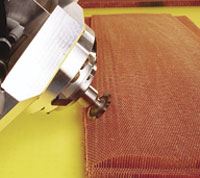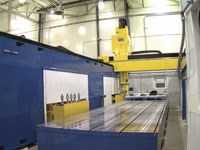Automated Aircraft Repair Closer To Reality
Inspection and Repair Preparation Cell (IRPC) unveiled, revealing progress made toward automated aircraft repair workcells.
A recent conference hosted by American GFM (AGFM, Chesapeake, Va., a member of the worldwide GFM machine tool organization) highlighted an important ongoing initiative to improve military aircraft repair practices through automation. The Inspection and Repair Preparation Cell (IRPC) concept is the latest in an ongoing series of programs championed by the GFM organization to address the need for keeping military aircraft flying — while minimizing repair down time.
The IRPC concept was discussed briefly in HPC's recent aircraft repair article (HPC May 2005, p. 56). A "cell" would include a 3-D digitizing station, nondestructive testing (NDT), radio frequency identification (RFI) tagging, advanced collision avoidance technologies, automated machining to remove damage, plus cutting of repair plies and core plugs and even automated finite element analysis to assist repair technicians. Intended initially for repairs of nose radomes on the C-130 and the radomes and speed brakes on the F-15, IRPC cells would help increase the work pace for frequent and critical repairs. Costs of the project are being shared between the Commercial Technologies for Maintenance Activities (CTMA) group, a collaborative effort of the U.S. Department of Defense (DoD) and the National Center for Manufacturing Sciences (NCMS, Ann Arbor, Mich.), and a group of industry suppliers, including the GFM organization. The initial cell has been proposed for Robins Air Force Base (Warner Robins, Ga.) and CTMA funding is anticipated by June. The proposed 15-month project is envisioned to demonstrate maintenance cost savings and faster processing time. At the successful completion of the prototype project, final design and manufacture of the first full cell is expected in 2007.
AGFM's Frank Elliott, the company's IRPC initiative coordinator, says that while some advanced technologies have already been incorporated into the defense maintenance and repair environment, many obstacles remain to streamlining and automating repairs that are routinely required. Operations that could benefit from automation include detection of damaged areas; routing and grinding to cut out defective areas; and preparation of replacement core plugs and skin plies, says Elliot. Bill Waddell, NCMS's project manager, notes, "The opportunity for automation has been limited by the lack of capability to create a three-dimensional computer data model, which is needed for computer-controlled processes on parts as large as these." A C130 radome, which is planned to be one of the parts repaired in the initial cell, is about 2.5m/8-ft tall and 1.85m/6-ft in diameter.
Conference speakers shared their perspectives on how automated technologies will be incorporated into the IRPC. The nondestructive testing step was identified as crucial to accurate damage detection — at present, a technician manually divides the part surface into a grid and performs a tap test. In contrast, the IRPC will automatically and rapidly generate an electronic surface grid with a noncontact 3-D digitizing system, to support accurate defect detection. Scott Ackerson of Dimensional Photonics International Inc. (DPI, Burlington, Mass.) described his product's "3-D shape scanning" ability. The technology works on the principle of accordion fringe interferometry (AFI) developed at the Massachusetts Institute of Technology (MIT). A laser, mounted on the end of a robotic arm, illuminates the object with an interference fringe pattern achieved by splitting a laser beam into two point sources. The illumination fringes strike the part and, depending on its contour, are seen as curved by a camera positioned at a known angle from the laser source. The degree of apparent curvature coupled with the known angle between the camera and laser source enables the AFI algorithm to triangulate the surface topology — creating a "point cloud" of data, essentially a 3-D photo of the part — to form a baseline for the downstream repair activities, achieving accuracy within 0.002-inch.
To test for damage, NCMA's Waddell says that a number of appropriate NDT technologies are likely to be qualified during this initial phase of cell prototyping. One under consideration is laser shearography, as supplied by Steinbichler Optotechnik GmbH (Neubeuern, Germany). Laser shearography works by stressing the part with vacuum, vibration or heat and measuring the resulting surface deformation with a laser scanner. According to AGFM, Steinbichler's technology is notable because it is able to perform measurements of damage boundaries within a 3-D model environment. Steinbichler has installed a somewhat similar automated body inspection system in an Audi automotive production plant (as reported in HPC's sister publication Composites Technology, April 2004, p. 17) and thus has acquired production-rate experience in flaw detection, says company representative Rainer Huber.
One hurdle is how to support and shuttle large parts from station to station in the cell while maintaining very tight tolerances and accuracy during various procedures. According to Elliott, parts will be mounted on palletized fixtures that can move in and out of stations, while securely holding them in the same orientation — an orientation similar to their position on the aircraft — throughout all cell processes. Another important aspect discussed during the presentations is that anything introduced into the cell environment — including hand tools or smaller parts — has to be tracked with radio frequency identification (RFI) technology to ensure collision avoidance with robotic machinery and personnel.
The GFM organization's role in IRPC is to provide a CNC machining center that not only can cut the damaged material from the part but also can cut new repair plies and core on the fly. An integral part of the AGFM cutting system is laser projection capability, provided by Assembly Guidance Systems Inc. (Chelmsford, Mass.). Integrated laser-guided kitting and automated ply verification capability, developed by Assembly Guidance, are integral parts of the AGFM cutting systems, says Scott Blake, president of Assembly Guidance. A hand-held, remote verification device, termed the HAMPI (high-accuracy manually positioned inspector), is placed on the layup at positions indicated by the laser guidance system to verify that the proper plies are in position, notes Blake.
Cutting will be accomplished with a 6-axis ultrasonic cutting and routing machine, outfitted with new carbide knife cutter tools that are able to make fewer, deeper cuts, resulting in less tool wear and fewer tool changeouts. After the damaged area is removed, patch material, including core, will be cut to match the shape exactly.
The IRPC team fully expects that, with the new cell, labor time will be cut by at least 30 percent and maintenance cost savings will be on the order of $2 million (USD). Total funding for the project is $2.4 million, with industry partners providing $1.6 million. Training for cell operation will be provided with the assistance of Mike Hoke (Abaris Training Inc., Reno, Nev.). Elliott stresses that the IRPC concept can be applied to any type of component (composite or metal), in repair or manufacturing modes. The conference generated considerable interest and input from participating end-users, including technicians from Warner Robins AFB and representatives of aircraft manufacturers. HPC will stay abreast of IRPC developments in future issues.
Related Content
Manufacturing the MFFD thermoplastic composite fuselage
Demonstrator’s upper, lower shells and assembly prove materials and new processes for lighter, cheaper and more sustainable high-rate future aircraft.
Read MoreA new era for ceramic matrix composites
CMC is expanding, with new fiber production in Europe, faster processes and higher temperature materials enabling applications for industry, hypersonics and New Space.
Read MoreJeep all-composite roof receivers achieve steel performance at low mass
Ultrashort carbon fiber/PPA replaces steel on rooftop brackets to hold Jeep soft tops, hardtops.
Read MorePlant tour: Joby Aviation, Marina, Calif., U.S.
As the advanced air mobility market begins to take shape, market leader Joby Aviation works to industrialize composites manufacturing for its first-generation, composites-intensive, all-electric air taxi.
Read MoreRead Next
Developing bonded composite repair for ships, offshore units
Bureau Veritas and industry partners issue guidelines and pave the way for certification via StrengthBond Offshore project.
Read MoreVIDEO: High-volume processing for fiberglass components
Cannon Ergos, a company specializing in high-ton presses and equipment for composites fabrication and plastics processing, displayed automotive and industrial components at CAMX 2024.
Read MorePlant tour: Daher Shap’in TechCenter and composites production plant, Saint-Aignan-de-Grandlieu, France
Co-located R&D and production advance OOA thermosets, thermoplastics, welding, recycling and digital technologies for faster processing and certification of lighter, more sustainable composites.
Read More
























